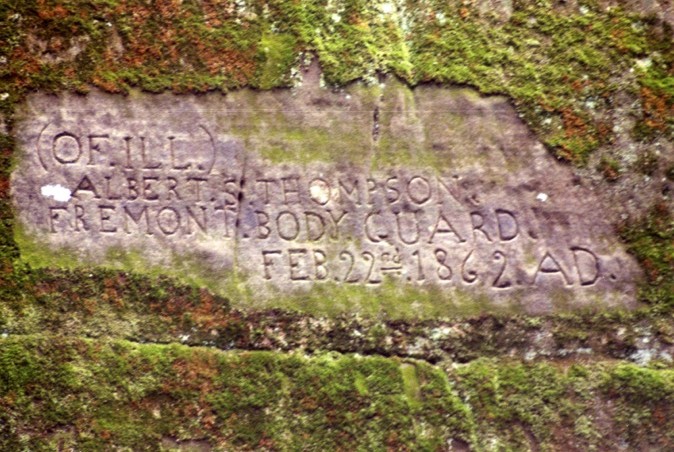
This last spring Mark Wagner and Eraina Nossa of the Center for Archaeological Investigations prepared National Register of Historic Places (NRHP) nominations for five prehistoric rock art sites located on state and federal land within Illinois. We are happy to report that all five have been accepted and are now listed on the NRHP.
CAI staff are currently working on five additional rock art site nominations, three prehistoric and two historic. The prehistoric sites include the Trestle Hollow site, which consists of 22 pit and groove designs engraved on a vertical rock face within the Shawnee National Forest (SNF) overlooking the Mississippi River. Although this site was not officially recorded until the 1970s, a recently discovered photograph shows that the site was known as early as the 1950s (Figure 1). The white chalk, which the photographers used to make the images stand out, has long since washed away.

Ca. 1950.
The second prehistoric site being nominated to the NRHP is the Prang site, which also is located on SNF land. A geologist named Henry Worthen first described this site in the 1850s, but it was not relocated by archaeologists until the 1980s (Figures 2-3).


The Prang site contains numerous petroglyphs including grooves, bowl-like depressions, bird tracks, a human figure, and other designs (Figures 4-5). A small charcoal-drawn pictograph also was discovered during a 2014 visit to the site.


The three historic sites (Thompson, Battery Rock, and Henry Angel) are located on both federal (SNF) and state (Illinois Department of Natural Resources) land. All three consist of names and other images carved by Union soldiers during the Civil War. Southern Illinois, which had been settled by southerners, was split in its loyalty during the Civil War and we suspect that all three sites may have been created as a warning to southern sympathizers in the region.
This is definitely the case with the Thompson site where two brothers, Albert and T. W. carved their name and unit (the Fremont Body Guard, which was an elite regiment organized by John C. Fremont early in the war) as a warning to southern sympathizers known as the “Knights of the Golden Circle” in rock overhangs located on their land (Figure 6).

John Henry Angel, who served in the 6th Illinois Cavalry, may similarly carved his name on creek bedrock (Figure 7) as a warning to his southern leaning neighbors when he was home on leave. An officer in his regiment had in fact been shot to death by Union deserters only a few miles from where Angel carved his name.

The third site is located at Battery Rock, which was a landing on the Illinois side of the Ohio River during the Civil War (Figure 8). At least twice during the war southern partisan “rangers” from Kentucky blocked the Ohio River at this point and robbed passing steamboats of supplies and money. The Union Army rushed troops to Battery Rock in response, some of whom appear to have been from Indiana, who carved their names and an American flag on the rock face (Figure 9).


We expect all five nominations to be completed by next summer, with the three Civil War sites being the first historic period rock art sites within Illinois to be nominated to the NRHP.
